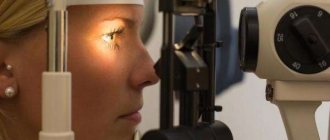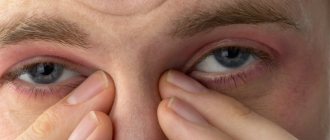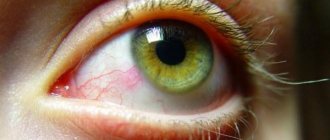Sparks in the eyes can occur when the sensing and conducting apparatus of the optical system malfunctions. Most often, these changes occur due to retinal pathology. Sparks are like small dots that appear in different areas of the visual field and can scatter in different directions.
An interesting suggestion is that the sparks are leukocytes, that is, white blood cells that move within the vascular bed. Usually the patient practically does not notice them, but with a rapid increase in the diameter of the vessels, for example, as a result of a change in body position, the patient perceives them as sparks before the eyes. However, this theory is more a hypothesis than truth.
When looking at a bright, flat surface (a white illuminated sheet, a clear sky), almost anyone can see sparks. They are represented by dim light dots that move chaotically within the field of view. This phenomenon is also called photopsia.
Causes
Flickering can be completely harmless.
It occurs in healthy people due to poor diet, alcohol abuse, wearing incorrectly selected vision correction products, taking certain medications, emotional exhaustion, poisoning, overheating or sunstroke. But the reasons may be much more serious. Flickering may be caused by the following health problems:
- Migraine. Shortly before the attack, the patient may experience sparkles, sparkling patterns, or bright white zigzags in front of the eyes. They are present in one eye or in both eyes at once, and most of them accumulate on the side in peripheral vision. May increase when eyes are closed or in the dark.
- Damage to blood vessels. With chronic vascular diseases that destroy the structure of arteries and veins, bunnies may appear in the field of view. This is caused by spasms and poor circulation. The symptoms are most noticeable when the eyes are closed.
- Hypertension. With increased pressure, different figures may flicker before the eyes, which is accompanied by headache, dizziness, decreased performance and increased fatigue.
- Hypotension. With a decrease in pressure, the vessels experience a lack of blood, which can cause different patterns to flicker before the eyes.
- Diabetes. The disease, left untreated, leads to serious damage to the blood vessels of the brain and eyes. There may be glare in front of both eyes, bright flashes, floaters, temporarily blurred parts of the visible image, as well as a feeling of constant coldness.
- Anemia. A decrease in hemoglobin levels is always combined with dizziness, weakness, shortness of breath, dry skin, general pallor of the body, trembling of the limbs, and tinnitus. Often, spirals, stripes or dots appear in front of the eyes.
- Brain tumor. As tumors grow, compression of blood vessels and nerves occurs, which causes flashing of various figures before the eyes, which can be black, white or even colored. The phenomenon is permanent and can cause difficulty focusing.
- Head or eye injuries. In most cases, even minor injuries cause flashes of bright light, confusion, weakness and headaches.
- Inflammation of the retina. Against the background of the inflammatory process, the image begins to blur, and an unpleasant flickering of flies or dots is formed.
- Vitreous detachment. This almost always happens as the body ages. When the vitreous peels off, it causes flashes of light, sparks, and discolored spots that make the entire picture turn white. Symptoms intensify with eye movement and are localized laterally.
- Retinal tear or detachment. With ruptures and detachments of the retina, flashes may appear before the eyes, which are often accompanied by haze and sudden blurred vision. This is most pronounced in the morning after sleep.
- Oscillopsia. With this disease, it may seem to a person that when he turns his head, some objects begin to fly or jump to another place. This is accompanied by flickering in the eyes, the appearance of white spots, as well as a short-term decrease in vision up to its complete absence.
- Cervical osteochondrosis. Bunnies appear in the eyes when the vertebrae are displaced, which causes pinching of nerve endings and blood vessels. Patients almost always experience unpleasant pain that comes in the form of a wave.
- Hormonal changes. They occur during pregnancy, menopause, and puberty. They are almost always accompanied by short-term blinking of jagged threads, dots, and shiny spots in front of the eyes in the area of peripheral vision.
- Eclampsia. With late toxicosis, sunbeams, bright stripes or dots may appear that will glow and slowly fly before the eyes.
With any of the listed diseases, flickering can become a permanent phenomenon, because Without treatment, no positive changes can occur. If there is a suspicion that the disease has developed, then a person has a serious reason to consult a doctor.
Causes
Experts identify several main negative factors that contribute to the appearance of flickering in the eyes. The reasons for the ripples in the eyes may be hidden in the following factors:
- Hereditary predisposition, and of the total number of manifestations of the problem this figure is 70%;
- Higher rates of such disorders (90% of cases) appear in older people;
- About 5% of this manifestation is diagnosed in childhood and adolescence.
Women suffer from such changes more often than men.
- Ophthalmological pathologies;
- Dystrophy of cartilage tissue in the sewing vertebrae due to osteochondrosis;
- Arterial hypertension;
- Migraine;
- Vegetovascular dystonia;
- Acute forms of pathologies of the cardiovascular system;
- Brain tumor (when the tumor grows, it compresses the nerves and blood vessels, so all kinds of figures flash before the eyes - black and white or color, this phenomenon is constant, it worsens the process of focusing the gaze).
All these conditions are characterized by short-term starvation of the brain due to poor blood circulation, which causes the occurrence of a similar symptom. The causes of glare in the eyes that contribute to the appearance of this condition also include:
- Head injuries;
- Exhaustive diets;
- Poor nutrition;
- Nervous exhaustion;
- Pregnancy;
- Constant lack of sleep;
- Overwork;
- A sharp rise after a horizontal position;
- Long trips in transport;
- Taking medications;
- Alcohol abuse;
- Temperature surges and meteorological changes in the atmosphere.
With any of these diseases and conditions, glare can be permanent, since without health-improving measures no positive changes are observed.
If such symptoms occur, you should definitely consult a doctor.
- Severe cough;
- Sneezing;
- Sudden change in body position;
- Vomiting.
Such provocateurs put too much strain on the human vestibular apparatus, causing a short-term increase in intracranial pressure. After this, zigzags appear in the eyes for a short time, they look dull, disappear quickly, and do not appear again. After a few seconds, the state is restored, and the person completely forgets that an atypical visual perception was observed.
Preventive actions
Preventive measures to prevent symptoms are quite simple but effective. Compliance with them will help to avoid flickering in the eyes or reduce the likelihood of such manifestation to a minimum. Here are some expert tips on what you can do on your own to maintain good eye health:
Adequate fluid intake
Water is not only vital for the cells of our body, but also helps eliminate toxins that accumulate over time. Lack of fluid and a large amount of toxic substances can cause ripples in the eyes and intense headaches. Drink 1.5 – 2 liters of water daily to maintain good health.
Complete rest
Even with the busiest schedule, leave yourself time to relax and get a full 8 hours of sleep. When working in front of a computer monitor, do not forget to take breaks.
The optimal ratio: 1 hour of work and 5 minutes of break, during which it is recommended to do eye exercises. You can alternately move your gaze from objects that are far away to objects that are close to you. This will help avoid symptoms and prevent headaches. Do not forget to ventilate the room, otherwise the lack of oxygen will cause “snow” in the eyes and dizziness.
Less coffee and cigarettes
The ideal solution would be to completely avoid nicotine and caffeine, but if you cannot eliminate these substances from your life, minimize their use. They are strong irritants and often lead to severe headaches, blurred vision and nausea.
Nutritious food
| Don't forget about the enormous importance of proper nutrition for your body. Try to diversify your diet, choose seasonal vegetables and fruits, prefer products that have not undergone any additional processing. |
Take vitamin complexes in the spring, when their deficiency is acute. Eat more carrots, blueberries and blueberries, which improve vision. Don't forget about blackberries, which have a calming effect on the human nervous system.
What can cause outbreaks?
Let's consider the most likely causes of this pathology. Flashes in the eyes may appear in the following cases:
- Inflammatory processes occurring in the vitreous body of the eye. This disease is called retinitis.
- The appearance of a tumor on the retina.
- The choroids of the eye, which provide blood supply to the retina, become inflamed. This disease is called choroiditis.
- The optic nerve becomes inflamed and leads to the development of a disease called neuritis.
- Retinal detachment.
Symptoms such as flashes in the eyes do not have a negative impact on visual function. But this symptom cannot be ignored, as it may conceal the development of a serious disease. To prevent pathological processes occurring in the retina and other problems in the functioning of the visual system, it is necessary to undergo a timely diagnosis by visiting an ophthalmologist.
There are other types of diseases in which flashes or flickering may occur. These include:
- Diabetes.
- Cervical osteochondrosis.
- High or low blood pressure.
- Anemia.
- Internal bleeding.
- Toxin poisoning.
- Pain in the head.
- Increased intracranial pressure.
Causes of sparks
The causes of sparks before the eyes can be very diverse. This depends on the location of the pathology. After all, when sparks appear not at sharp tilts, this already indicates the presence of a pathological disorder. So, sparks in the eyes are the reasons for their occurrence:
- Destructive changes in the vitreous body. This reason is the most common. If the reason lies precisely in destruction, then the patient notes additional floating spots of various sizes and shapes.
- Vitreous detachment from the posterior side is observed due to age-related changes, and therefore occurs after 50 years. In this case, the vitreous body shrinks, which leads to deformation and stretching of the retina in the places where it is attached. As a result, flicker is formed.
- Spasms in the vessels of the visual organs. This happens most often with surges in blood pressure and other pathologies of the circulatory system, as well as with diabetes.
- A retinal tear is a significant injury that causes hemorrhage into the eye cavity. This condition is called hemophthalmos. When the retina ruptures, visual acuity rapidly decreases and a veil forms. If measures are not taken in a timely manner, the retina may detach, and this already leads to more serious disorders requiring surgical intervention.
- Retinal detachment. When the retina detaches, the sparks appear reddish or may be dark.
- Eye injury. This could be a blow to the head, a mechanical impact directly on the visual apparatus.
- Severe squeezing of the eyes. If you press your finger on a closed eye, the person will definitely see a sparkling flicker. This state is called mechanophosphene.
- Neoplasms inside the visual apparatus or in the brain.
- Inflammatory processes in tissues.
- Other causes of sparks in the eyes in the dark or in the light: fatigue, wearing glasses with damaged lenses, rubbing the eyes, drinking alcohol, drugs, smoking. As well as sudden movements, looking at bright lights, etc.
Feeling sick after sleep
If there are some problems with the retina, the patient may find that glare and flashes appear in the eyes after sleep. We are talking about a violation of the integrity of the retina. Retinal tears often lead to detachment and significant deterioration in visual function, including blindness.
Usually the retina is damaged due to its dystrophy, which develops due to:
- genetic predisposition;
- myopia;
- injuries to the visual organs;
- cataracts;
- surgical intervention;
- hypertension;
- diabetes mellitus;
- vitamin deficiency;
- intoxication and other factors.
The integrity of the retina is disrupted due to a sudden jump, bending, lifting a heavy load, severe stress, high pressure, head injury, or removal of the lens.
However, breaks do not always lead to retinal detachment. Timely treatment plays a big role in this, thanks to which it is possible to stop the progression of the pathological process.
The severity of symptoms depends on where the rupture or detachment is located. When the retina is stretched in the affected area, the patient, after waking up, sees various flashes before his eyes; rather, this is a temporary symptom. If a veil appears, there is most likely a detachment, so postponing a visit to the doctor may result in vision loss.
How to get rid of a symptom
Various treatment methods are used to eliminate photopsia:
- prescription of medications;
- use of homeopathic remedies;
- surgical intervention.
The medication course is aimed not at combating the light phenomena themselves, but at eliminating the factors that gave rise to them. Medicines are selected taking into account the main diagnosis that caused the problem. The patient may be prescribed drops that relieve inflammation of the eyes, tablets and injections that normalize intraocular pressure. If the pathology is associated with the course of diabetes mellitus, they turn to insulin therapy.
For minor disorders that occur due to stressful conditions, during pregnancy or menopause, homeopathic products are used. Patients are prescribed drugs such as Ignacia, Viola Odorata, Senega, Carboneum sulfuratum.
If the disorder manifests itself against the background of retinal detachment or local hemorrhage, surgical treatment is prescribed. An effective procedure is laser coagulation, during which damaged vessels are cauterized. In some cases, there is a need to completely remove the vitreous.
Flashes in the eyes in the dark or when eyes are closed
| As a rule, the indicated effect manifests itself in the dark or with closed eyes. This is due to the fact that bright flashes are clearly visible against a dark background. |
Moreover, in the dark, the human eye does not perceive surrounding objects. Accordingly, the gaze does not focus on them. Therefore, manifestations of internal processes become more noticeable.
Vascular pathologies
Such pathologies are associated with damage to the eye capillaries. This may be a consequence of infection or severe overexertion. If there is a deviation in the development of blood vessels, it leads to poor blood supply to the eye.
| Insufficient nutrition with useful elements leads to weakening of the eye muscles and nerves. As a result, the effect of flares is observed against this background. |
Ocular migraine
This condition is observed due to severe stress. Nervous tension causes a serious condition of the entire organ of vision. The blood vessels become tense, causing them to burst. This will cause your eyes to hurt a lot. There is severe pressing pain. It can be so strong that it causes a flash effect.
Why do sparks appear in the eyes?
- Destruction of the vitreous body. This pathology is the most common cause of sparks appearing before the eyes. Their occurrence is accompanied by the appearance of floating spots of various shapes and sizes.
- Vitreous detachment. People over 50 years of age are often diagnosed with vitreous wrinkling, the most complex pathology of the vitreous body. This deformation leads to severe tension at the attachment points of the vitreous body to the retina. As a result, sparks appear when the eye moves. They are especially noticeable when your eyes are closed.
- Vascular anomalies. Often the appearance of sparks before the eyes accompanies hypertension, diabetes mellitus and other diseases associated with vascular damage. Spasms occur in the eyes, which cause the appearance of foreign objects.
- Retinal tears. In some cases, the appearance of sparks is associated with damage to the retina. Against the background of its rupture, a vessel rupture may occur. As a result, blood enters the eye cavity and hemophthalmos occurs. This condition is accompanied by the appearance of a veil over the entire field of vision and a decrease in the acuity of vision of the world. A retinal tear can cause retinal detachment. This is fraught with serious consequences for vision. If sparks occur, you should immediately seek help from an ophthalmologist.
- Retinal disinsertion. This disease is one of the most dangerous in ophthalmology, as it can lead to complete and irreversible loss of vision. When the retina is detached, sparks of red and purple colors, as well as dark shades, appear in front of the eyes. The intensity of objects increases over time. All this is accompanied by active deterioration of vision.
- Eye injuries. Sparks occur immediately at the moment of injury - impact or other mechanical impact. If the concussion was mild, over time all unpleasant symptoms disappear.
- Head injury. The visual centers are located in the occipital part of the brain. A blow to this area may be accompanied by a sensation of sparks “falling” from the eyes.
- Pressure on the eye. If you press lightly, a light spot may appear in your field of vision. This phenomenon is called mechanophosphene. When the pressure stops, it disappears, so this condition is not a pathology.
- Tumors inside the eyes. If a tumor develops inside the eye, it can cause sparks over time. This is due to the fact that during the process of growth it begins to put pressure on surrounding tissues.
Causes of flashes in the eyes
The indicated flashes are a manifestation of internal problems. They do not arise on their own without reason.
Therefore, it is important to consider the main causes of symptoms:
Damage to the vitreous
It is located in the inner areas of the eye and occupies most of it. This is a very dense structure. However, with injuries or infections, the vitreous body can be seriously damaged. The resulting damage is expressed in flashes. A person sees them and perceives them as flashes. But in reality it is a display of damage.
| Cloudiness and other defects occur deep inside the eye. However, they also have an external manifestation, forming the effect of flashes. As a rule, this leads to the development of infection. Hemorrhages form inside the body. It is they who are perceived as flashes. |
Migraine
This condition occurs against a background of nervous exhaustion and extreme tension. Nervous activity leads to unbearable headaches. Against this background, it is very difficult for a person to perceive even quiet sounds. Pain is caused by any irritants - smells, normal walking. And its intensity is reflected in the form of a flashing effect.
Retina
This organ of the eye allows you to normally perceive surrounding objects. The retina can be damaged as a result of a burn, toxin poisoning, or shock. Any of these factors leads to the development of pathologies. They do not always appear instantly, but develop over a long period of time.
The effect described above becomes a tangible expression of such processes. In this case, outbreaks will not be accompanied by pain or inflammation of the eyes
But you need to pay attention to them if the effect has become regular.
Vessels
They permeate the entire eye organ. These are the smallest blood capillaries that react sharply to shock, poisoning, and infections. Any influence leads to injury to these vessels. They burst and the eye begins to hurt. If the damage is severe, it will be expressed in flashes. It is pain that leads to these manifestations;
Tumors
They are formed in the brain. Extremely dangerous as they can be fatal. It grows and inevitably begins to affect the organ of vision. This action manifests itself in an increase in pressure inside the eye and leads to a flashing effect;
Inflammatory processes
Inflammatory processes are caused by infection. This may be conjunctivitis, blepharitis, iritis, keratitis. In these situations, severe redness of the eyes is observed. This occurs due to damage to blood vessels - capillaries. Intense inflammation develops against a background of pain and suppuration.
| Such symptoms strain the eyes, which leads to flash effects. |
Consequences of injuries
Serious injuries result in damage to the eye organs. They can affect the retina, vitreous body, lens, and so on. With severe eye strain, injuries make themselves felt, manifesting themselves in a flash effect;
For cervical osteochondrosis
In this case, outbreaks are also characteristic of acute human conditions. Nerve endings are pinched. The person cannot turn his head normally because he is in severe pain. As a result, a flashing effect appears.
Eye sparkle effect
Bright luminous points, called sparks, can be observed periodically or be constant. A person is able to see them under various circumstances:
- in bright light;
- when looking at a white background;
- with eyes closed.
Experts associate the appearance of photopsia with impaired retinal or vitreous function. If such a phenomenon does not go away for a long time, the person experiences severe discomfort and anxiety, loses the ability to fully work, or navigate in space.
Prevention
Preventing the problem involves organizing the following activities;
- Low-intensity training;
- Hiking;
- Good nutrition;
- High-quality sleep that eliminates fatigue;
- Avoidance of stressful conditions;
- Elimination of habits harmful to health;
- Complete treatment of infections;
- Swimming;
- Limiting time in front of a monitor screen;
- Prevention of osteochondrosis;
- Timely moisturizing of the eyes;
- Regular blood pressure measurement (this is important after reaching the age of 40);
- You should definitely ventilate the room where a person stays for a long time.
If you carefully follow the recommendations given, you will be able to minimize the risk of developing most diseases.
Causes of glare and flicker
Vessels and nerve of the eye
If flickering spots appear more than once a week, this is a reason to seek medical help. Unfortunately, without an examination it is difficult to determine the main reason for the appearance of these signs, ObaEglaza believes. The list of possible pathologies is too extensive to immediately diagnose the disease.
Bunnies in the eyes, as they are also called, can indicate damage to the retina, peeling of the membrane, swelling of the cornea and sometimes the onset of cataracts. The cause of the disorders may be frequent attacks of headaches developing into migraines, significant enlargement of the pupils, unsuitable or damaged lenses.
There are also more serious problems, according to ObaGlazaR, that cause glare in the dark, for example, metabolic and metabolic disorders, inflammatory processes, diabetes mellitus, fluid stagnation due to blood flow disorders. With the latter, the brain is not enriched with oxygen, this leads to flashes, glare and midges before the eyes. You may lose consciousness. If your eyes blink during serious poisoning, this means a signal from the body indicating damage to the central nervous system and, accordingly, the optic nerve by toxic substances.
Most often, midges appear before the eyes of people with hypertension or hypotension. Due to changes in blood pressure, there is a large load on the blood vessels of the body, including the blood vessels of the eyes. The retina of the eyes is very sensitive to such changes and causes glare. The same happens with traumatic brain injuries and internal bleeding. Any disturbance in the functioning of the central nervous system affects the organs of vision.
Important: Pregnant women, says ObaGlazaRu, should pay special attention to the dot flickering in front of their eyes. You should immediately consult a doctor to rule out eclampsia. When blood pressure reaches such levels that it can threaten the life of the mother and child.
When blood pressure reaches such levels that it can threaten the life of the mother and child.
People who are addicted to smoking and drinking alcohol may experience blinking in their eyes more often than others. Regular stress and heavy emotional stress lead to an increase in the load on the organ of vision. Exposure to ultraviolet rays can make glare worse. To protect against them, it is recommended to choose special optics with tinted glass lenses; tinted plastic lenses will not help.
Flickering is not always caused by abnormalities in the body, notes obaglazaRu. Sometimes the eyes can react to changes in hormonal levels in the body. This is not considered a serious cause for concern, but to protect yourself and avoid serious consequences, you should get tested.
Getting rid of flickering objects in the eyes
When flickering zigzags, spots, glare in the eyes and other objects constantly appear before your eyes, you need to consult an ophthalmologist. First of all, the specialist will determine the cause of the disease. And based on the reason for its appearance, the doctor will prescribe a course of treatment.
Typically, treatment involves:
- the use of antibacterial and antiviral drugs (when the cause of flickering was infectious diseases);
- taking medications that normalize blood pressure;
- prescribing a course of vitamins;
- using medications that will lower glucose levels, as well as reviewing diabetes treatment (if diabetes is the cause);
- other therapy, which depends on the cause of the unpleasant sensations.
Doctors' advice and prevention
If a person begins to experience unpleasant sensations in the form of the appearance of flickering objects, then he should:
- Watch your diet (the human body must receive enough vitamins and microelements). Be sure to eat fruits, vegetables, fresh herbs, and nuts. The best helpers for the eyes are dried apricots, blueberries, and apricots. It is recommended to include beef liver, veal, and pomegranate juice in your diet (they prevent the development of anemia).
- Avoid overexertion. You need to alternate work with rest (especially when working at a computer). Take breaks, give your eyes a rest (you can close your eyes for a while or do gymnastics that are beneficial for the visual organs). It is advisable to walk daily, providing the body with the necessary amount of oxygen.
- Give up bad habits (drinking alcohol, smoking).
- Reconsider the course of treatment when taking medications or stop taking them for a short time (when the cause of flickering was taking medications).
- Do physical exercises, therapeutic exercises, massage. These preventive measures will have a positive effect not only on the organs of vision, but also on the entire body as a whole.
Causes
If sparks in the eyes rarely appear, the pathology may be caused by long hours of work at the computer, stressful conditions, or nervous strain. Photopsia also occur against the background of severe intoxication of the body, after trauma to the skull, damage to the occipital part of the head containing the visual centers.
The anomaly can be caused by wearing glasses with damaged lenses, drinking alcohol, drugs, or actively smoking. Sometimes the pathological phenomenon worries pregnant women and menopausal patients.
The appearance of luminous “spots” is caused by pressing on the eyeballs, long-term fixation of the gaze on the sun or other bright sources of light. In such cases, the anomaly goes away on its own within a few minutes.
Methods of treating pathology
Treatment methods entirely depend on the reasons that caused the development of such a pathology. To establish a diagnosis, you will need to consult an ophthalmologist. For more complex diseases, such as oncology, examination by other specialists is required.
There are two types of surgical treatment of diseases:
- Removal of pathology with laser. The affected areas of the retina are targeted with a laser beam. But this method of therapy is used very rarely, as it is poorly studied.
- Surgical intervention. This method removes the vitreous body of the eye and replaces it by applying a special solution. This method of treatment is used in rare cases, as it can lead to retinal detachment, cause hemorrhage and clouding of the lens.
If flashes in the eyes are not associated with serious diseases, drugs are used aimed at normalizing metabolic processes and eliminating symptoms in the form of flickering and flashing.
- To strengthen the blood vessels of the eye, Emoxipin 1% is used. The medicine is intended to protect the vitreous body of the eye from the negative effects of ultraviolet radiation. The product also reduces the likelihood of hemorrhage and helps normalize fluid circulation in the visual organ.
- The inflammatory process can be relieved with Wobenzym. This medicine has an analgesic effect, normalizes blood structure, and provides adequate nutrition to tissues.
If the cause of the outbreaks is retinal detachment, laser coagulation and surgery are used. For inflammatory processes, the doctor may prescribe antibacterial agents and corticosteroid drugs. If the disease is oncological in nature, complex therapy will be required.
Drug therapy and surgery
If sparks from the eyes appear due to any disease or disorder, then therapy is aimed at getting rid of the main problem. For hypertension, the doctor will prescribe medications that normalize blood pressure, etc. But if retinal or vitreous detachment is observed, then surgical intervention is prescribed. This operation is called vitrectomy. It involves removing the vitreous. Gas or silicone is tamponed onto the freed area. For minor hemorrhages, laser coagulation can be performed. In many cases, eye drops are also prescribed, which eliminate inflammatory processes and stop the development of pathology.
Diagnosis and treatment
Before prescribing treatment, specialists analyze the health status of the visual organ itself. Using special equipment, the condition of the fundus is studied and the level of vision loss is determined.
Diagnosis of eye diseases
It is recommended to visit a physician and have intraocular and intracranial pressure measured. A general blood and urine test will help determine abnormalities in the activity of the whole body. Self-medication in this situation will lead to partial or complete loss of vision.
Therapy for floaters and flickering consists of treating the underlying disease that caused such characteristic deviations. Eliminating the cause completely restores the clarity and quality of vision. Drug treatment includes:
- 1. Taking medications against viruses and bacteria.
- 2. Taking medications that regulate blood pressure. During therapy, the patient is advised to constantly monitor blood pressure throughout the day.
- 3. Strengthening the immune system and restoring the deficiency of certain microorganisms by taking vitamin complexes is useful to do several times throughout the year.
If a patient suffers from diabetes, then a new treatment for the disease is selected, leading to a decrease in the concentration of glucose in the blood. If the issue is excessive blood loss, then it is necessary to stop the cause and restore the lost volume.
Proper diet
The main sign that treatment is not working is a decrease in vision clarity. In this case, it is necessary to urgently change the course of treatment.
Sometimes it is enough to change your diet and eat more foods that are healthy for the visual organ. These products are:
- nuts,
- greenery,
- fruits,
- vegetables,
- blueberry.
It is important to balance your diet and consume more healthy proteins. It is necessary to give up bad habits, consult with your doctor about adjusting the dosages of medications taken on an ongoing basis, and eliminate less necessary ones.
The drug that causes flicker is replaced with another drug. If a patient works in an office and is forced to spend every day in front of a monitor, he is recommended to do preventive exercises to strengthen the visual muscles and give the eyes more rest.
Treatment
It is important to understand that “sparks in the eyes” are not a separate disease, but only a symptom of a certain pathological condition of the organ of vision. And when the cause that caused it is eliminated, this phenomenon instantly disappears. Therefore, if sparks appear from the eyes, the cause of which is not clear or is due to heavy physical activity or severe stress, it is imperative to visit an ophthalmologist to rule out serious eye pathologies that threaten vision loss, such as retinal detachment.
In the medical department, everyone can undergo examination using the most modern diagnostic equipment, and based on the results, receive advice from a highly qualified specialist. The clinic provides consultations to children from 4 years old. We are open seven days a week and work daily from 9 a.m. to 9 p.m. Our specialists will help identify the cause of vision loss and provide competent treatment of identified pathologies.
You can find out the cost of a particular procedure or make an appointment at the Moscow Eye Clinic by calling 8 (800) 777-38-81 (daily from 9:00 to 21:00, free for mobile phones and regions of the Russian Federation) or using the form online entries.
Dagaev Adam Huseinovich
Possible disorders accompanied by flickering in the eyes
Vascular diseases. With hypertension and diabetes, patients constantly complain of flashes in the eyes. This happens when there is a sudden change in lighting or simply when your eyes are closed. Such flickering indicates short-term spasms and poor circulation in the retina
Considering that the development of diseases begins with a flicker in the eyes in the dark, I advise you to first of all pay attention to the problem of vascular diseases. Retinal tears and detachment
Often, flashes or flickering in the eyes (not only when the lighting changes) are a symptom of the onset of retinal detachment. Most often they appear after physical exertion or due to severe stress, when the patient, in addition to flickering, has a veil before the eyes or even a sharp drop in vision. These symptoms cannot be ignored, and the disorder requires immediate treatment. Posterior vitreous detachment. “Vitreous humor” is the gel-like substance that fills the central part of the eye. The vitreous body is attached to the retina, and over the years the process of its detachment may begin. Thus, pressure begins to be exerted on the retina of the eye, which leads to flashes and flickering in the eyes. Most often it can appear when moving the eye. With this violation, the main thing is not to waste time, because delay can lead to a serious complication - complete retinal detachment, which, in turn, threatens vision loss. Migraine. With the development of this disease, the next attack may be accompanied by preliminary symptoms - flickering and flashes in the eyes. Sometimes migraine attacks are painless only against the background of flashes and flickering in the eyes. This type of migraine is called an “ocular” migraine. Eye or head injuries. Quite often, it is after injuries that a person develops problems with the eyes, which are characterized by periodic flashes, the appearance of “midges” and flickering.
Treatment of the disorder occurs only after the root cause has been determined. The disease “flicker in the eyes” does not exist in itself. This symptom is only a consequence of the development of a certain disease, so you can get rid of it only after the ophthalmologist establishes the cause and prescribes active therapy for the underlying disease. You may have to consult another doctor if the essence of the problem lies outside the scope of the ophthalmologist’s competence. But one thing is certain: the disease should not be hushed up, especially since “innocent” symptoms may indicate the development of irreversible complications.
Causes of sparks in the eyes.
1. Destruction of the vitreous body
. The most common cause of sparks in the eyes. In this case, the appearance of sparks is accompanied by the appearance of floating spots of various shapes and sizes.
Sparks destruction of the vitreous body video
2. Posterior vitreous detachment
. In people over 50 years of age, as a result of the aging of the eye, wrinkling of the vitreous body occurs. Due to deformation, the vitreous creates tension on the retina at its attachment points. When the eye moves, flickering or small luminous sparks appear.
Sparks vitreous detachment video
3. Vascular spasms in the eyes
may lead to this symptom. Especially often, sparkles in the eyes can be noticed by people suffering from hypertension and other vascular diseases, such as diabetes.
4.Retinal tears
manifested by a sensation of sparks in the eyes, which indicates damage to the retinal tissue. If a retinal rupture is accompanied by a rupture of a vessel, then blood flows into the eye cavity, causing hemophthalmos. In this case, a veil appears before the eye and vision decreases. A retinal tear leads to the development of retinal detachment, therefore, if a symptom of sparks occurs, you should immediately consult an ophthalmologist.
5.Retinal detachment
. With these diseases, sparkles before the eyes may be the earliest symptoms. A characteristic feature is the appearance of red or dark sparks, which are repeated and their intensity increases each time. At the same time, vision loss occurs.
6. Eye injury
can be of various types. If there is a strong mechanical impact at the moment of impact, sparks may appear in the eye.
7.Head injury
often accompanied by a feeling that “sparks were falling from the eyes,” especially with bruises in the occipital region, where the visual centers of the brain are located.
8. Pressure on the eye
may also cause a sensation of sparks. This phenomenon is known to ophthalmologists as mechanophosphene, when when pressed with a finger or some object on the eye, a luminous spot appears, similar to a spark. When the exposure stops, the stain disappears.
9.Intraocular tumors
. This symptom may also appear.
Treatment and preventive measures
Of course, it is not the zigzags themselves that are treated (you remember that this is an illusion), but the diseases that gave rise to them. Or, if it is not a disease, the causes are eliminated.
How is photopsia treated? Like other diseases - with medications. But they are not aimed at eliminating lightning in the eyes, but at eliminating the pathology that gave rise to them. The patient is prescribed drug therapy in accordance with the disease. If it is an eye disease, such as a detached retina, or an eye injury, surgery may be required before he can no longer see lightning in his vision.
Retinal tear and detachment
As for preventive measures, they are not complicated and are as follows.
- Moderate non-intensive sports.
- Physical activity that replenishes oxygen deprivation.
- Hiking.
- Bicycle (at a relaxed pace).
- Complete nutrition.
- Healthy sleep to avoid overwork.
- No stress.
- Quitting habits that are harmful to health
- Treatment of infections on time and to the end.
- Swimming.
- Prevention of osteochondrosis (prevention of spinal curvature).
- Limit time spent on screens.
- Elimination of the “dry eye” effect.
Dry eye syndrome
Most importantly, do not forget that flickering zigzags are just an anomaly and an unpleasant symptom. Therefore, it is not worth getting rid of it on your own, even with the help of medications that “one neighbor recommended” or traditional medicine. In any case, you must first obtain the doctor’s approval and his recommendations regarding treatment, so as not to harm yourself and, while trying to get rid of lightning in your eyes, not to lose your vision.
Video - Lightning in the eyes, reasons why flashes appear in the right or left eye
linzopedia.ru
Flashes in the eyes are one of the important signs indicating disturbances in the functioning of the retina. This phenomenon in medicine is called photopsia. The retina has the ability to generate nerve impulses and transmit them to the brain, thus forming a visual image. Many people are interested in why flashes in the eyes are sometimes accompanied by dizziness, spasmodic pain in the head and decreased visual function. Let's try to understand the reasons for the appearance of such symptoms, and at the same time consider how to deal with them.
Possible diseases
Some pathologies can occur with the appearance of photopsia. The list of such diseases includes:
- Myopia.
- Detachment, ruptures of the retina.
- Destruction of the vitreous body.
- Hypertension.
- Vegetative-vascular dystonia.
- Oncological processes in the brain, organs of vision.
- Diabetes.
- Hypotension.
Sparks and flashes in the eyes can appear against the background of an infectious lesion of the body. The symptom occurs in persons with impaired metabolism and vascular spasms.










